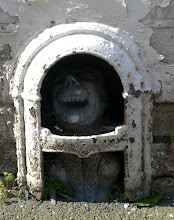Mitcham is a strange place. A modern shopping precinct, flats, trading estates and light industrial units have washed over a Surrey village famed for its lavender fields that could have rivalled Dulwich for attractiveness. Most of the glory of Mitcham lies in the remaining houses that are sprinkled around the twin centres of the village pond and the Cricket Green. The development seems to have been mainly post war and there's not too many old Victorian terraces or shops around but there are still a few interesting bits and pieces.
Eagle House, Holburne Road/London Road
One of two eagles guarding the entrance to a marvellous French Chateau of a building.
 Figge's Marsh
Figge's MarshRight on the corner is this high-visibility clock, which is sadly not working...
 Upper Green East
Upper Green EastThe Estate Agent has long gone and it's now a bookmakers.
 London Road, Mitcham
London Road, MitchamThere was very little evidence of Victorian decoration, but I did come across these two nice sections of tile-work almost next to each other.

 Cricket Green, Mitcham.
Cricket Green, Mitcham.Another clock, this one on the old cricket club house. Apparently it's the oldest cricket green in England and Nelson used to stop by to watch a few overs.
 Cricket Green, Mitcham
Cricket Green, MitchamDown the side of the clubhouse is this interesting old bell that doesn't look as though it gets much use these days. I wonder if it originally used to signal tea-breaks?
 London Road/Cricket Green
London Road/Cricket GreenA nice horse trough, but the really interesting inscription is on the other side. Apparently commissioned for Queen Victoria's jubilee, any attempt to photograph it would have been decidedly dangerous!
 Vestry Hall, London Road
Vestry Hall, London Road Another clock, this one on the attractive Vestry Hall building. An excellent example of local civic pride and ambition
 Vestry Hall, London Road
Vestry Hall, London RoadI assume that this small plate is a Fire point and would have indicated the presence of a water main in Feet and Inches. Looks as though that has been erased though.
 Lower Green West, Mitcham
Lower Green West, MitchamEasily overlooked by virtue of being on the edge busy one-way section of road the old Village School is a really impressive building with its own bell and clock-tower
 The inscription shows it was founded in 1788 but developed in 1812. The tower was added later, but it's a very interesting building all round.
The inscription shows it was founded in 1788 but developed in 1812. The tower was added later, but it's a very interesting building all round.


2 comments:
I was really excited to see the photo of the Board School as my Great Great Grandfather was a Master there during the late 1800's and early 1900's.
The upper picture of tiling on the pilaster looks very similar to those found on The Broadway in Wimbledon, opposite the theatre
Post a Comment